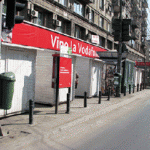Brocade, heavy velvet, wool clothing, this is how people used to get dressed more than a hundred of years ago. This is why, when they entered the concert halls, their clothes and the plush of the chairs made a perfect combination for the music to sound crystal clear. The sound absorption coefficients depended so much on the clothes of the spectators, that when the fashion changed, the sound of some halls simply faded away.
And I remembered this just a couple of days ago, at Balanescu’s concert, while I was standing with my knees held tight, stuck on the tiny chair, between the narrow rows of TNB (Bucharest National Theatre). Lucky that nowadays fitted t-shirts do not require too much space! How could anyone take her hoop skirt? Better dress with blue jeans and a t-shirt. In the main hall, the most important, it’s better to stay on the stage, than on these chairs. The spectator has to understand what a difficult thing music is, even to feel it on his own. I want either to stretch my body, or the bis to end more quickly, cause, really, it already hurts me! Nevertheless, the acoustics may be as it is, equalized by the mixer, but the deadly chairs and the general dust from the atmosphere succeed to break any infusive experiences. Anyway, it was better than at the play I saw a month ago, played in a smoked bar, on a stage lacking any depth, without any setting, any distances that may generate the mirage. An issue, even for a rebel play. In the end, parasite shows have a serious form of existence and they end up being called “conversions”, actually some transformations thoughtfully planned from the beginning till the end, which make the re-usage of the space have some sense, coherence, and above all, success.
After 17 years, the whole Bucharest culture bears an extempore atmosphere. Would you like to see a theatre play? There is an attic, or a foyer. Do you want to go for a concert? There is a cellar, and a bar at the same time, with smoke, and a lot of noise. Everything develops in inappropriate spaces, which doesn’t matter anyway, since we keep adapting. Anything is good enough to be parasite-ridden by a cultural activity. We might see a sign of health and vigor in this, of enthusiasm and energy in a society, which looks for its evolution resources and takes advantage out of any opportunity of producing art. Some of them work, some don’t. In a way, some might say that the underground is flourishing; it is almost the primary culture. This happens because that which is the “big and heavy” culture, well institutionalized does not get adequate spaces and gets old. All that we inherited from the old times is exhausted and dusted nowadays. We need new halls for spectacles, exhibitions, for theatre, opera, for a capital with an intense cultural consumption.
For the moment we are using what we have, we are patching here and there, we gracefully enter residual spaces, free of charge if possible, until public investments will focus on something that we might also enjoy. I’m talking about spaces for plays, or for civilized exhibitions, wide enough for 2 millions of inhabitants and an active cultural life.
I’m also telling you that in the fashion and design capital, Milan, Salone del Mobile took place, and it was celebrated as a New Year Party. A new year of design was actually celebrated. May then be Design in this issue.


